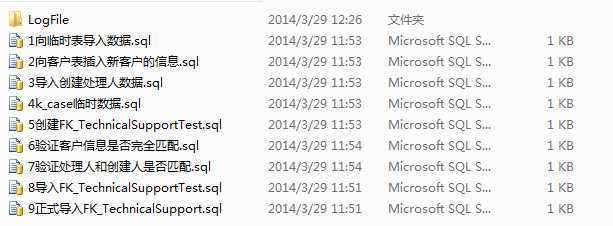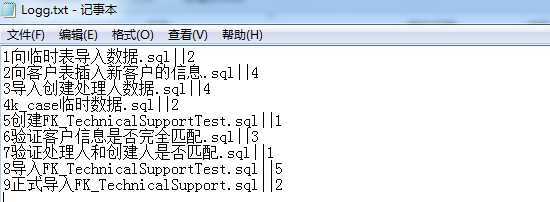标签:style blog class code java ext
通过SqlClr制作Sql自动化批量执行脚本
在与同事一起做项目时,看到同事用sqlclr做批量执行脚本,感觉挺新奇的就上网搜集资料自己模仿跟做了个案例,
感觉挺不错的,现在想和大家分享一下,可能存在些错误的地方,大家就做个小参考吧....
1.我们在做数据迁移或是数据库结构修改时,通常会写一些脚本文件之后逐个运行。但是如果有数十或数百个脚本文件,
那么就可以通过SqlClr制作Sql自动化执
2.比如现在ImportDataScript文件夹内有些脚本文件:

3.我们想让这9个脚本文件自动的依次执行,并且输出最终的执行情况并且生成一个日志写到ImportDataScript文件夹内的
LogFile文件夹内的Logg.txt中。
4.我们预期结果:
执行结果:(执行每个文件的开始时间、结束时间、执行总时间)

输出日志:(名称、执行时间)

5.思路:首先我们通过sqlclr创建一个表值函数来获取脚本文件的本地路径的集合,然后遍历这个集合并通过sql exec xp_cmdshell命令
来执行指定路径下的脚本文件,并通过sqlclr创建一个记录日志的的标量函数来逐条记录执行日志。
5.1创建sqlclr项目
5.1.1创建实体类:
1 public class FilePathModel 2 { 3 public FilePathModel() 4 { 5 6 } 7 public FilePathModel(string fileName, string filePath) 8 { 9 this.FileName = fileName; 10 this.FilePath = FilePath; 11 } 12 private string _FileName; 13 14 public string FileName 15 { 16 get { return _FileName; } 17 set { _FileName = value; } 18 } 19 private string _FilePath; 20 21 public string FilePath 22 { 23 get { return _FilePath; } 24 set { _FilePath = value; } 25 } 26 }
5.1.2创建表值函数:
1 public partial class UserDefinedFunctions 2 { 3 [Microsoft.SqlServer.Server.SqlFunction 4 (DataAccess = DataAccessKind.Read, 5 TableDefinition = "FileName nvarchar(100),FilePath nvarchar(100)", 6 FillRowMethodName = "FillTable", IsDeterministic = true)] 7 public static IEnumerable GetScriptFilePath(SqlString fileRootPath) 8 { 9 10 IList<FilePathModel> list = new List<FilePathModel>(); 11 if (Directory.Exists(fileRootPath.Value)) 12 { 13 DirectoryInfo di = new DirectoryInfo(fileRootPath.Value); 14 foreach (FileInfo fi in di.GetFiles()) 15 { 16 list.Add(new FilePathModel { FileName=fi.Name,FilePath=fi.FullName}); 17 } 18 } 19 return list; 20 } 21 public static void FillTable(object obj, out SqlString fileName, out SqlString filePath) 22 { 23 fileName = ""; 24 filePath = ""; 25 FilePathModel fpModel = obj as FilePathModel; 26 if (fpModel != null) 27 { 28 fileName = fpModel.FileName; 29 filePath = fpModel.FilePath; 30 } 31 } 32 };
5.1.3创建写入日志的标量函数:
1 public partial class UserDefinedFunctions 2 { 3 [Microsoft.SqlServer.Server.SqlFunction] 4 public static SqlString ImportLog(SqlString pathStr, SqlString strName, SqlString Time) 5 { 6 // 在此处放置代码 7 8 if (Directory.Exists(pathStr.Value)) 9 { 10 string filePathNew = Path.Combine(pathStr.Value, "Logg.txt"); 11 FileInfo fi = new FileInfo(filePathNew); 12 if (!File.Exists(filePathNew)) 13 { 14 fi.Create(); 15 } 16 using (StreamWriter sw = fi.AppendText()) 17 { 18 sw.WriteLine(strName.Value + "||" + Time.Value); 19 } 20 return new SqlString("完成"); 21 } 22 else 23 { 24 return new SqlString("失败"); 25 } 26 } 27 };
5.2写执行脚本:
--开启sqlclr sp_configure ‘show advanced options‘, 1; GO RECONFIGURE; GO sp_configure ‘clr enabled‘, 1; GO RECONFIGURE; GO --使用.net framework ALTER database Test SET TRUSTWORTHY ON ALTER assembly DataImprot with permission_set = external_access go -- --开启【xp_cmdshell】权限 exec sp_configure ‘xp_cmdshell‘, @configvalue = 1 reconfigure with override go --开启【opendatasource】权限 exec sp_configure @configname = ‘Ad Hoc Distributed Queries‘, @configvalue = 1 reconfigure with override --测试 DECLARE @fileRootPath nvarchar(100) DECLARE @logFilePath nvarchar(100) DECLARE @serverName nvarchar(100) DECLARE @dataBaseName nvarchar(100) DECLARE @loginName nvarchar(100) DECLARE @passWord nvarchar(100) --服务器名 SET @ServerName=‘PACTERA_GZF-PC‘ --数据库名 SET @dataBaseName=‘Test‘ --用户名 SET @loginName=‘sa‘ --密码 SET @passWord=‘sa‘ --脚本根路径 SET @fileRootPath=‘D:\ImportDataScript‘ --日志文件路径.txt SET @logFilePath=‘D:\ImportDataScript\LogFile‘ DECLARE @FilePathTable table ( [FileName] nvarchar(100), FilePath nvarchar(100) ) create table #CurFilePathTable ( Id int identity(1,1) primary key, [FileName] nvarchar(100), FilePath nvarchar(100), BeginTime datetime, EndTime datetime, ExcuteDate float ) insert into @FilePathTable select [FileName], [FilePath] from dbo.GetScriptFilePath(@fileRootPath) declare @FileName nvarchar(100) declare @FilePath nvarchar(100) declare @BeginTime datetime declare @EndTime datetime declare @sqlStr nvarchar(200) declare cur_FilePath cursor for select [FileName], [FilePath] from @FilePathTable open cur_FilePath fetch next from cur_FilePath into @FileName, @FilePath while (@@fetch_status = 0) begin set @BeginTime = getdate() set @sqlStr = ‘exec xp_cmdshell ‘‘osql -S ‘+@ServerName+‘ -U ‘+@loginName+‘ -P ‘+@passWord+‘ -i ‘ + @FilePath + ‘‘‘‘ exec master..sp_executesql @sqlStr set @EndTime = getdate() print @FileName insert into #CurFilePathTable ([FileName], FilePath, BeginTime,EndTime,ExcuteDate) values (@FileName, @FilePath, @BeginTime,@EndTime,datediff(second, @BeginTime, @EndTime)) select dbo.ImportLog(@logFilePath,@FileName,convert(varchar(10),datediff(second, @BeginTime, @EndTime))) fetch next from cur_FilePath into @FileName, @FilePath end close cur_FilePath deallocate cur_FilePath select * FROM #CurFilePathTable DROP TABLE #CurFilePathTable
5.3总结:
感觉SqlClr就像是插件模型,通过嵌入.dll来实现更多的功能。
利用SqlClr我们可以做许事情比如我们也可以在sqlserver端实现数据的加密解密等。
通过SqlClr制作Sql自动化批量执行脚本,布布扣,bubuko.com
标签:style blog class code java ext
原文地址:http://www.cnblogs.com/guozefeng/p/3705064.html